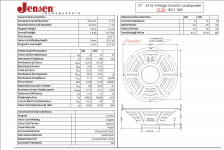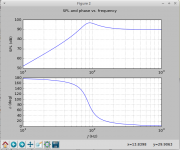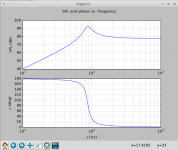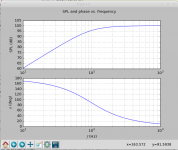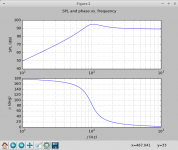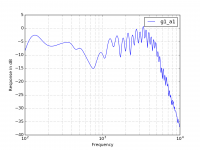...the high source impedance of a valve guitar amp makes nonsense out of most of the TS parameters anyway. For example, Qts and Qtc become irrelevant.
I have seen T/S data for g-speakers, fer instance:
C12Q | Jensen Loudspeakers
Qes scales directly with the electrical Ohms. Qes of 2, at 6 Ohms, then add 18 Ohms of tubes, makes Qes near 8. (Which as you said, is a big spike.) In many Fenders the tube NFB is about unity damping, so Qes of 2 becomes Qes of 4.
If effective Qes is small relative to mechanical Qs, then Qts is about Qes. For 18r added the new Qes of 8 is close to the Qms of 13, so some figuring is needed. I quesstimate Qts becomes like 5, which is still a tall/narrow peak. However if you put this +14dB bump at the -6dB point of an open-back cabinet, you get +/-6dB from midbass down to a much lower frequency than you could get from a sealed box of the same van-space. For Fender Twin, Qts like 3, the +9dB peak put with the -6dB droop of an open-back makes a response flatter than most rooms.
Excellent find, thank you!I have seen T/S data for g-speakers, fer instance:
C12Q | Jensen Loudspeakers
I have been tinkering with speaker response math (essentially re-doing Thiele/Small without converting everything over from masses and springs to inductors and capacitors as they did), and I wrote some Python code to generate speaker frequency responses from my equations. So I'm able to generate frequency responses from the T/S data for the C12Q, with and without additional (output) resistance from the amp.
Results are attached. T/S data, speaker fed from zero ohm source impedance, same speaker fed from 18 ohms source impedance. Free-air/ infinite baffle in both cases.
(SPL is not properly normalized for 2.83V drive signal, but the frequency response curve itself should be right.)
-Gnobuddy
Attachments
Celestion "Vintage 30" - Thiele Small Parameters wanted
the WGS Retro 30 has follow parameters:
Resonant Frequency (Fs) 98 Hz
DC Resistance (Re) 6.90 Ohm
Coil Inductance (Le) 0.38 mH
Mechanical Q (Qms) 15.53
Electromagnetic Q (Qes) 0.61
Total Q (Qts) 0.59
Compliance Equivalent Volume (Vas) 1.35 cu ft (x 0,02832 m3 x 1000 = ~ 40 liters)
Mechanical Compliance of Suspension (Cms) 0.10 mm/N
BL Product (BL) 13.88 T-M
Diaphragm Mass Inc. Airload (Mms) 27.69 grams
Surface Area of Cone (Sd) 53.24 cm squared
Sound Pressure Level (spl) 100 db
Celestion Blue Thiele Small Parameters | The Gear Page
New Celestion Blue:
Zmin 7.04 ohm
fmin 305 Hz
f3 734 Hz
Le(f3) 0.845 mH
Motional impedance parameters
RES 371.01 ohm
LCES 24.362 mH
CMES 162.7 uF
RAMS 371008.544 mohm
Blocked impedance parameters
RDC 6.00 ohm
dR 0.06 ohm
Re 6.06 ohm
Leb 71.4 uH
Le 2.530 mH
Rss 2340.5 ohm
Ke 0.1090 S-H
Thiele-Small parameters
fs 79.9 Hz
Qms 10.771
Qes 0.496
Qts 0.474
Fts 168.7
Mms 38.86 g
Cms 0.102 mm/N
Rms 1.812 kg/s
Vas 38.98 litres
Bl 15.454 Tm
Eta 3.92 %
Lp (1W/1m) 98.10 dB
Dd 25.71 cm
Sd 519.0 cm^2
Vb 30.000 litres
G12M it replaced:
Zmin 7.71 ohm
fmin 274 Hz
f3 762 Hz
Le(f3) 0.958 mH
Motional impedance parameters
RES 280.60 ohm
LCES 22.115 mH
CMES 175.6 uF
RAMS 280602.397 mohm
Blocked impedance parameters
RDC 6.00 ohm
dR 0.73 ohm
Re 6.73 ohm
Leb 80.7 uH
Le 2.640 mH
Rss 2856.5 ohm
Ke 0.1287 S-H
Thiele-Small parameters
fs 80.8 Hz
Qms 8.766
Qes 0.600
Qts 0.561
Fts 143.9
Mms 48.21 g
Cms 0.081 mm/N
Rms 2.791 kg/s
Vas 30.78 litres
Bl 16.569 Tm
Eta 2.64 %
Lp (1W/1m) 96.37 dB
Dd 25.71 cm
Sd 519.0 cm^2
Vb 30.000 litres
G10 too:
Zmin 7.40 ohm
fmin 316 Hz
f3 1120 Hz
Le(f3) 0.654 mH
Motional impedance parameters
RES 196.58 ohm
LCES 10.765 mH
CMES 193.6 uF
RAMS 196584.707 mohm
Blocked impedance parameters
RDC 6.00 ohm
dR 0.58 ohm
Re 6.58 ohm
Leb 62.2 uH
Le 1.844 mH
Rss 2215.6 ohm
Ke 0.1053 S-H
Thiele-Small parameters
fs 110.3 Hz
Qms 8.481
Qes 0.883
Qts 0.800
Fts 137.9
Mms 27.16 g
Cms 0.077 mm/N
Rms 2.219 kg/s
Vas 12.88 litres
Bl 11.846 Tm
Eta 1.91 %
Lp (1W/1m) 94.97 dB
Dd 20.93 cm
Sd 344.0 cm^2
Vb 31.000 litres
the WGS Retro 30 has follow parameters:
Resonant Frequency (Fs) 98 Hz
DC Resistance (Re) 6.90 Ohm
Coil Inductance (Le) 0.38 mH
Mechanical Q (Qms) 15.53
Electromagnetic Q (Qes) 0.61
Total Q (Qts) 0.59
Compliance Equivalent Volume (Vas) 1.35 cu ft (x 0,02832 m3 x 1000 = ~ 40 liters)
Mechanical Compliance of Suspension (Cms) 0.10 mm/N
BL Product (BL) 13.88 T-M
Diaphragm Mass Inc. Airload (Mms) 27.69 grams
Surface Area of Cone (Sd) 53.24 cm squared
Sound Pressure Level (spl) 100 db
Celestion Blue Thiele Small Parameters | The Gear Page
New Celestion Blue:
Zmin 7.04 ohm
fmin 305 Hz
f3 734 Hz
Le(f3) 0.845 mH
Motional impedance parameters
RES 371.01 ohm
LCES 24.362 mH
CMES 162.7 uF
RAMS 371008.544 mohm
Blocked impedance parameters
RDC 6.00 ohm
dR 0.06 ohm
Re 6.06 ohm
Leb 71.4 uH
Le 2.530 mH
Rss 2340.5 ohm
Ke 0.1090 S-H
Thiele-Small parameters
fs 79.9 Hz
Qms 10.771
Qes 0.496
Qts 0.474
Fts 168.7
Mms 38.86 g
Cms 0.102 mm/N
Rms 1.812 kg/s
Vas 38.98 litres
Bl 15.454 Tm
Eta 3.92 %
Lp (1W/1m) 98.10 dB
Dd 25.71 cm
Sd 519.0 cm^2
Vb 30.000 litres
G12M it replaced:
Zmin 7.71 ohm
fmin 274 Hz
f3 762 Hz
Le(f3) 0.958 mH
Motional impedance parameters
RES 280.60 ohm
LCES 22.115 mH
CMES 175.6 uF
RAMS 280602.397 mohm
Blocked impedance parameters
RDC 6.00 ohm
dR 0.73 ohm
Re 6.73 ohm
Leb 80.7 uH
Le 2.640 mH
Rss 2856.5 ohm
Ke 0.1287 S-H
Thiele-Small parameters
fs 80.8 Hz
Qms 8.766
Qes 0.600
Qts 0.561
Fts 143.9
Mms 48.21 g
Cms 0.081 mm/N
Rms 2.791 kg/s
Vas 30.78 litres
Bl 16.569 Tm
Eta 2.64 %
Lp (1W/1m) 96.37 dB
Dd 25.71 cm
Sd 519.0 cm^2
Vb 30.000 litres
G10 too:
Zmin 7.40 ohm
fmin 316 Hz
f3 1120 Hz
Le(f3) 0.654 mH
Motional impedance parameters
RES 196.58 ohm
LCES 10.765 mH
CMES 193.6 uF
RAMS 196584.707 mohm
Blocked impedance parameters
RDC 6.00 ohm
dR 0.58 ohm
Re 6.58 ohm
Leb 62.2 uH
Le 1.844 mH
Rss 2215.6 ohm
Ke 0.1053 S-H
Thiele-Small parameters
fs 110.3 Hz
Qms 8.481
Qes 0.883
Qts 0.800
Fts 137.9
Mms 27.16 g
Cms 0.077 mm/N
Rms 2.219 kg/s
Vas 12.88 litres
Bl 11.846 Tm
Eta 1.91 %
Lp (1W/1m) 94.97 dB
Dd 20.93 cm
Sd 344.0 cm^2
Vb 31.000 litres
Looking at the C12Q numbers, I have doubts. Compare 8r to 16r.
The 8r has higher mass and lower force factor, so (for the same cone area) should be lower efficiency. They show the 8r has higher no. But a hair less sensitivity.
The difference is hard to explain by simply changing wire gauge and turns 1.414X and then rearranging for practical design (you need a whole number of turns and preferably an even number of layers). I wonder if the typist got cross-eyed.
The 8r has higher mass and lower force factor, so (for the same cone area) should be lower efficiency. They show the 8r has higher no. But a hair less sensitivity.
The difference is hard to explain by simply changing wire gauge and turns 1.414X and then rearranging for practical design (you need a whole number of turns and preferably an even number of layers). I wonder if the typist got cross-eyed.
in voice coils, only option is 2 layers, so thinner wire means less weight.and preferably an even number of layers
It´s not a transformer where thinner wire can be compensated by winding more layers so keeping winding weight about the same.
That said, I also have some gripe about Jensen figures.
Eminence always states an efficiency "number" higher (many times up to 3 dB) than what graphs show, while Jensen always quotes a consistently lower one , often by 2 dB.
Look at the C12Q graph, say the 8 ohm one (almost same thing happens with the 16 ohm one, by the way), trace a horizontal line at stated 93.9 dB (found at 237Hz and 630Hz) and besides the dip at 399Hz, most everywhere else it´s well above that efficiency level, reaching very loud 97/98dB between 85 and 150 Hz, a very flat and loud full bottom octave, not just a wild narrow peak by any means , plus very loud 98dB+ between 950 and 4200Hz, full 2 octaves, reaching above 104 dB in the typical Guitar "scream" band between 2000 and 3500Hz.
In fact, I think the 93.9 line IS printed there, I see a faint line just below the 95dB line, just notice how much of the curve is *above* it.
NONE of that is even remotely indicated by the published "weak" 93.9dB "single number" rating.
It´s so unrealistic compared to all other published data (plus listening tests) that I guess it´s just a "Thiele Small type" software calculated rating, assuming the speaker works in the piston range.
Excellent to describe woofers and design "Thiele Small" approved cabinets with flat and deep Bass extension, useless (that´s an understatement) for Guitar speakers which are anything but deep woofers, under all accounts.
I´d love to feed a Guitar speaker band limited 80Hz to 4500Hz pink noise, actually *measure* SPL , one meter on axis, and post *that* number, which is much closer to actual use with Guitar amps.
Last edited:
Here we go, WGS Retro 30.the WGS Retro 30 has follow parameters:
Resonant Frequency (Fs) 98 Hz
DC Resistance (Re) 6.90 Ohm
Coil Inductance (Le) 0.38 mH
Mechanical Q (Qms) 15.53
Electromagnetic Q (Qes) 0.61
Total Q (Qts) 0.59
Compliance Equivalent Volume (Vas) 1.35 cu ft (x 0,02832 m3 x 1000 = ~ 40 liters)
Mechanical Compliance of Suspension (Cms) 0.10 mm/N
BL Product (BL) 13.88 T-M
Diaphragm Mass Inc. Airload (Mms) 27.69 grams
Surface Area of Cone (Sd) 53.24 cm squared
Sound Pressure Level (spl) 100 db
Comments:
1) Really nice strong magnet for a guitar speaker. Look how well controlled the bass resonance is (when driven with a zero-impedance amp.)
2) SPL drops when 18 ohms is inserted in series for the second simulation. My sim software doesn't (yet) know how to add output impedance to the amp while still maintaining the same drive voltage across the speaker terminals.
-Gnobuddy
Attachments
in voice coils ... gripe about Jensen figures.....
I have seen a 4-layer winding. I have not autopsied speakers in a very long time and do not remember if it was special. I have *seen* the gimmick to finish a 1 or 3 turn winding but it is inefficient of magnetics and nay be some artist fantasy. However the classic JBL 4" coils were wound with ribbon, one layer. The ribbon was brought back with little waste of gap volume.
Efficiency and Sensitivity are two very different things!!!
"1.7%" is the electro-acoustic conversion Efficiency in the flat zone of the piston range. (A more precise definition exists, but "up to 600Hz for a Twelve" is good enuff for now.)
"94dB" is the Sensitivity. There are many ways to get this number. Usually a weighted average over a specified frequency range. Very often mostly-midrange. Midrange is important. But also the midrange of large speakers is *above* the piston range, and elevated by directionality/beaming and by paper resonances.
If a speaker were designed "flat", the <piston Efficiency and the >piston Sensitivity could be corrected and spliced to form a flat response.
Guitar speakers are NOT flat, always rise from 500Hz-3KHz, with a series of peak/dip resonances. And this is often where the Sensitivity numbers are from. Moreover most detectors (including the Ear) are more impressed by the peaks and miss the dips, adding another few dB.
Last edited:
Cool, but 4 layer windings are seen in a few subwoofers, specially in Car Audio types, not what we are talking here by any means.I have seen a 4-layer winding. ...... However the classic JBL 4" coils were wound with ribbon, one layer. The ribbon was brought back with little waste of gap volume.
Useless for Guitar because the combination of very heavy coils and reduced magnetic flux because of the huge gap needed translate in *mud* sound (hence the basically subwoofer duty only) .
Edgewound ribbon voice coils are excellent, usually aluminum but there are a couple copper ribbon ones out there, and are a PA speaker thing.
Very very few such speakers have been used for guitar: JBL E/K-120/130 , EVM15L and Peavey versions: Black Widow and Scorpion, but the standard Guitar speaker uses 2 layer round copper wire voice coils .... at least 99.98% of them.
As a side note, and being an inveterate experimenter, I have built 12" Guitar speakers with custom made (and VERY expensive) edgewound aluminum voice coils , some on Kapton formers, some of thin epoxy-fiberglass sheet.
results were ... "interesting" .... but in actual use disappointing.
Speakers were loud sharp as a knife, but dry and thin, Bass was over damped and weak (for Guitar duty) , nobody liked them, while exact same components (magnet, cone, frame, etc.) but using classic roundwound copper wire were "what Musicians expected" and were preferred in all cases.
I ended up using those EWA coil speakers in Voice specific cabinets, where very clear and sharp midrange was a bonus.
Well, yes, one is an energy conversion efficiency (duh) indicator and is expressed as a % number, and too boot integrates all of the speaker acoustic output, in all directions; while "Sensitivity" as commonly used basically means SPL at *one* point, at a certain standard distance from speaker, at a given power input. Even the units are different.Efficiency and Sensitivity are two very different things!!!
Not sure about the usual English word, but we call "the full integrated" parameter, "adding all the tiny bits all over the place" an "extensive" parameter or property, while we call the value at a given point, ideally very small, an "intensive" parameter or property.
Personal view: the frequency graph curve shows a detailed map of "sensitivity" at each and every frequency .... and I see that published 93.9dB "single number" does NOT describe it.
If anything, I would be much happier with an average number, a weighted average would be best, considering all of the response, from throughs to peaks.
Or "physically average" it (instead of using Math tools) simply by feeding it pink noise.
Band limiting such noise to the range of interest would be even better from the point of view of the end user (the Guitar player).
Yes."1.7%" is the electro-acoustic conversion Efficiency in the flat zone of the piston range. (A more precise definition exists, but "up to 600Hz for a Twelve" is good enuff for now.)
My point is that such "number" is not too useful for a Guitar player.
Agree."94dB" is the Sensitivity. There are many ways to get this number. Usually a weighted average over a specified frequency range.
From what I see 93.9dB is not an average, weighted or otherwise.
In fact, the "lost" frequencies , around 350/400 Hz, are often called the "ugly" frequencies, typically attenuated by Guitar amp tone controls, go figure, while the typically boosted ones are those where the G12Q shines.
Just run the TSC tone stack simulator with Fender, Marshall and Vox tone controls and see what I mean.
Another consequence of what I mean: real old Guitar amps, such as old Fender ones and early VOX and Ampeg, used very crude or no tone controls, yet provided a very good Guitar sound which is significant even today.
How could they pull that trick successfully?
Just look at the C12Q frequency response:it "naturally" has boosted lows and highs at the proper frequencies, and attenuated "ugly mids"
A match made in Heaven, and which was further enhanced by old amps little or no use of NFB, which exaggerated Bass at resonance and highs above 1kHz.
That´s the point.Very often mostly-midrange. Midrange is important. But also the midrange of large speakers is *above* the piston range, and elevated by directionality/beaming and by paper resonances.
That´s why "all guitar speakers have their own voice and sound different".
Yes .... just that Guitar players do not like that.If a speaker were designed "flat", the <piston Efficiency and the >piston Sensitivity could be corrected and spliced to form a flat response.
Flat speakers are considered "boring" , "muddy" , or simply "do not cut through" .... specially besides a drummer which makes a lot of noise.
Further proof is that current bedroom recordings use no physical amps or cabinets, but DSP simulate amps and then add "cabinet impulses" to introduce all Guitar speaker "unflatness" or "special/secret sauce" he he.
Yes.Guitar speakers are NOT flat, always rise from 500Hz-3KHz, with a series of peak/dip resonances.
In C12Q 98dB and higher, up to 106dB or so.
"Often", may be, Eminence does that, considers the loudest part only, (just look at their curves) , while Jensen, in my opinion, is shooting itself in the foot by quoting a low number (which anybody can read and compare) , while not many can compare the curves side by side and clearly see the Truth by themselves.And this is often where the Sensitivity numbers are from.
Or even better, superimpose them.
In a nutshell, I trust all published *curves* by major manufacturers ; .... now the brochure/ad "single number" ? .... not that much since it almost never describes what the curves show.
In the long run, best that a regular Guitar player can do is put both speakers of interest side by side and switch back and forth between them while playing.
Agree, that´s my point too.Moreover most detectors (including the Ear) are more impressed by the peaks and miss the dips, adding another few dB.
I found the attached plot on the 'Net. It's a measurement of the frequency response of the Zoom G1on, one of those little DSP multi-effects boxes that includes guitar amp simulation....current bedroom recordings...DSP simulates amps..add "cabinet impulses" to introduce all Guitar speaker "unflatness"
The bizarre jagged frequency response you see is the result of the on-board speaker/cab emulation. All the messy peaks and dips in the original measured guitar speaker frequency response were captured and reproduced, and maybe made worse when re-implemented in a DSP filter.
I know from experience that when you measure a speaker in a room (not an anechoic chamber), you get many fine peaks and dips in the frequency response that actually do not come from the speaker at all, but rather from the rooms acoustic resonances/ sound reflections. The speaker itself tends to have a relatively smooth response, which you can see if you either use a proper anechoic chamber for measurements, or use one of the more modern speaker measurement systems that use gated impulses rather than a swept sine wave.
We can see here that Zoom made little effort to separate room modes from speaker response, so the G1on has this extremely ugly and erratic frequency response.
I wonder how this sounds to the ear. I suspect this sort of very jagged frequency response will sound harsh and cause ear-fatigue that you would not get from the real speaker in the real room.
-Gnobuddy
Attachments
> Zoom made little effort to separate room modes from speaker response
We "always" listen to speakers in rooms.
Yes, the emulation could have separated the speaker from the room. Speaker A B C, bedroom lounge stadium.
And in studio speaker is usually close-micced, no room sound.
But wrapping it all up makes an "obvious" change of sound, without many decisions.
We "always" listen to speakers in rooms.
Yes, the emulation could have separated the speaker from the room. Speaker A B C, bedroom lounge stadium.
And in studio speaker is usually close-micced, no room sound.
But wrapping it all up makes an "obvious" change of sound, without many decisions.
In the late 1990s, for a couple of years I was part of an engineering team trying to use DSP to flatten speaker frequency responses.We "always" listen to speakers in rooms.
Initially we tried to flatten the in-room response, and the results were always subjectively terrible - they sounded harsh and unpleasant.
The trouble seems to be that the human ear/brain doesn't seem to hear those multiple time-delayed room reflections the same way the measurement microphone does. Your ears and brain can tell sufficiently delayed signals from the direct line-of-sight ones, and your ears are not only directional, but you also have two ears spaced a little apart to sample the sound with.
After we started flattening anechoic-chamber frequency response of the drivers, the idea worked. The flat-anechoic-response speakers sounded better after moving them into a typical listening environment.
-Gnobuddy
yep, this is what I would expect to come out. Even without a scientific explanationThe flat-anechoic-response speakers sounded better after moving them into a typical listening environment.
-Gnobuddy
We have incredibly good space and phase sensors in our brains, plus a million years fine tuned processing algorithm, so we can do that very well.The trouble seems to be that the human ear/brain doesn't seem to hear those multiple time-delayed room reflections the same way the measurement microphone does. Your ears and brain can tell sufficiently delayed signals from the direct line-of-sight ones, and your ears are not only directional, but you also have two ears spaced a little apart to sample the sound with.
Just compare chatting with somebody across a table inside a very crowded and noisy Restaurant (train/bus station, noisy Subway, near jet engine, inside metallurgical Factory, near Nascar/Formula 1 racetracktrack, etc.) with a simultaneous recording through microphones placed between you, so suppossedly in the "best spot".
You will manage the face to face one very well, while recording will be absolutely useless.
And we are "deaf" compared to mice and bats
The first time I saw jerky hand-held video footage shot by an amateur carrying a camcorder in his hands, I wondered why we didn't get the same sort of jerky "video" from our eyes. After all, our eyeballs are also jerking about on top of our bodies as we walk or run....a million years fine tuned processing algorithm...
It was only recently that I found out the answer. Apparently there is a part of the eye/brain processing system whose job is to filter out all this the dizzy-making erratic background motion. Without this, we wouldn't be able to see clearly when we moved rapidly - we would see the same way a Go Pro video camera strapped to a helmet "sees". Blurry, jerky, nausea-inducing footage. Just imagine an animal that gets dizzy and falls over every time it tries to run from a predator!
It's absolutely amazing how much incredibly sophisticated signal-processing is constantly going on with all our senses!
-Gnobuddy
You may find this interesting!It was only recently that I found out the answer. Apparently there is a part of the eye/brain processing system whose job is to filter out all this the dizzy-making erratic background motion.
Here's why you can't see all twelve black dots in this optical illusion - The Verge
Thanks, nice illusion and article!You may find this interesting!
For years I've been pointing to optical and auditory illusions as proof that supposedly golden-eared audiophools shouldn't trust the "evidence" of their own senses. These illusions are crystal-clear proof that our senses can easily (and repeatedly) be fooled.
Not that anyone changes their opinion because of this. Those who want to believe in the magic sonic effects of Mpingo disks and paper-in-oil capacitors, will continue to believe, no matter what logical evidence to the contrary they are confronted with.
-Gnobuddy
- Home
- Live Sound
- Instruments and Amps
- Attenuator for a 15W to 25W guitar amp
